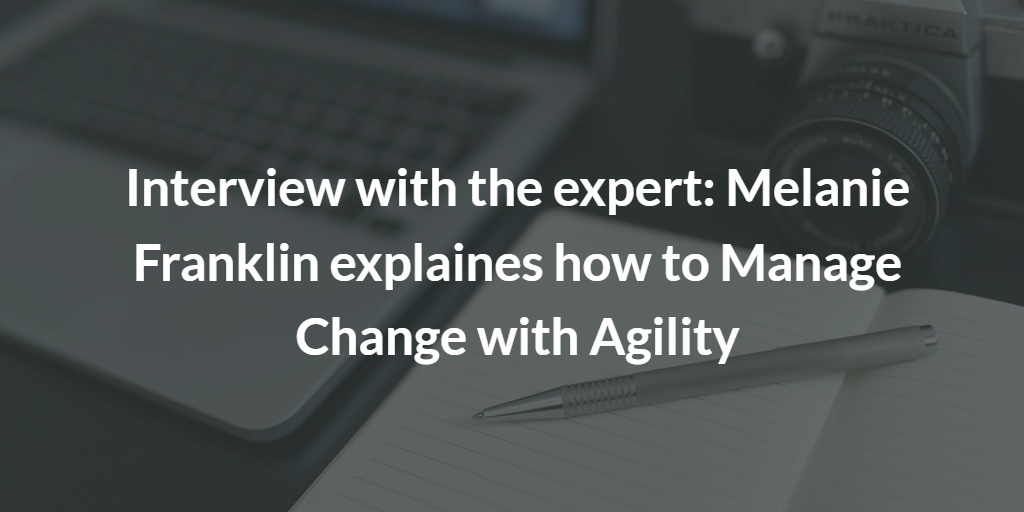Challenges and Opportunities in Agile Change Management: interview with Melanie Franklin

In a fast-paced, ever-changing digital world, all organizations have to deal with a high volume of change.
But are they well-prepared for this? Is it possible to learn how to be better at managing change in an agile world?
We are delighted to share our interview with Melanie Franklin, Co-Chair of the Change Management Institute UK, Director of Agile Change Management LTD and a respected author of textbooks and articles on change, project, and program management.
Melanie has dedicated the last 20 years to build the capability for change in organizations. She is a highly respected thought leader in change management with an impressive track record in the successful realization of business change programs across public and private sector organizations.
In 2014 she wrote the book “Agile Change Management”, setting out an approach for managing transformational change initiatives mainly using the ideas from the agile methodologies.
Can you tell me more about your career?
How did you come to the change management path?
I started as a Business Analyst, so my job was to look at how processes could run better. This was in global banking. I loved my job and I was promoted to project manager. I ran bigger and bigger projects until I became a Program Manager. As a program manager, I ran large scale transformational change programs, with more than 52 countries involved, so I did a lot of global change, but this was before we called it ‘change management’.
When we wrote the managing successful program book (Melanie authored Think MSP – a practical guide to how to run programs), we talked about how important it was to implement the changes we were creating. But we didn’t say how to manage the change: we said change management was very important but we didn’t say how to do it.
When APMG brought out the Change Management qualification in 2008 I really loved it so, I started using it with my consulting clients and I’ve used it, I’ve helped with ideas for the current version and I’ve been heavily involved writing on both agile and change because that’s what I do with my clients. They want to work in an agile way and they want to run very large scale change initiatives so, using traditional methods like PRINCE2® does not work, it’s too controlled and it implies you know everything at the beginning (which you don’t in change, you never do). Actually, it seemed obvious to me that bringing agile and change together was a good idea; I’m really pleased that I wrote the book Agile Change Management five years ago and I’m really pleased we’re taking into a qualification because it’s exactly what organizations keep asking me for: “How can we manage our change? We’ve got our IT department working in an Agile way and we need to roll the change out in small pieces. We need to do iterations, we need to build up versions.”
Finally, what we came out with it’s a very practical point of view. I had a very successful career as a program director but then I moved to training and consulting in program management and change management which I loved. And now my career is more focused on developing best practice, how we can do better.
So, you started the change management path and then the agility came later?
Yes, I think agility came to a couple of years after we started talking about change because, of course, as you start to do more change initiatives then you realize that change is always going to be “do a little bit, see what the reaction is, do a little bit more”. It naturally is an agile approach and I think that’s where I started to become very interested in agile methods. I went on every course you can imagine, I have every agile qualification. Because that’s how I learn, I always learn a practice first and then I can work on how to implement it. In the last few years, my enthusiasm has to lead me to chair the Change Management Institute in the UK as well. So, I’m very interested in building up recognition for the profession of Change Manager, to make sure that what we do as change management is recognized and appreciated.
How did you come up with the idea of Agile Change Management?
As I mentioned before, my clients wanted to work in an agile way and they wanted to run very large scale change initiatives. Using traditional methods couldn’t work because in an agile environment you don’t know everything at the start, so it seemed obvious to me that bring agile and change together was a good idea. What I wanted to do was to create something that did not assume that somebody being trained was going to be the expert who let the change, because I think that the effective Change Managers Handbook and the Change Management course do that brilliantly.
I also did not want to assume that the person needing to be trained was the person involved in the actual project that creates the tangible change (the AgilePM course does that); what I wanted was for somebody to have an understanding of how they might make change happens in the finance function, the marketing department, the operations unit, the call centre, whatever, that they are not experts on either agile or change but what they are is very good at managing their part of the business. But you have to give them a structure and an approach for managing change. This is what this new course does.
What’s the biggest challenge that you see in the agile and change management communities at the moment?
I think the biggest challenge is that with an agile approach you increase the number of changes that go live in an agile organization. Because change happens in every increment, it might be every sprint, and you’re ready to go live with something new. The problem we have is that the brain does not process this requirement to unlearn the old ways of working and learn new ways of working as quickly as we can produce the actual tangible change.
So, implementation and adoption are slower than creation and we end up with people feeling under tremendous pressure because they are struggling to deal with one change when another one comes in, and another one… and I think change and a high volume of change means we need to get better at managing change, we need to keep educating people that it is a skill they can learn. Because if we don’t I’m not sure that organization won’t get to breaking point.
Speaking on the behalf of professional change management, I think we still have to win the argument that change management is the secret to realizing benefits. If you have a project that creates something, it won’t realize benefits if it’s just getting things done – it becomes only a new way of working after a period of time when you see cost reduction, revenue increase, greater customer satisfaction, greater staff engagement. Unless we get the message that to actually run the change in a structured way, we need to use techniques to encourage people to participate and to encourage people and support people in working in new ways, we won’t get benefits.
This process is not automatic yet.








